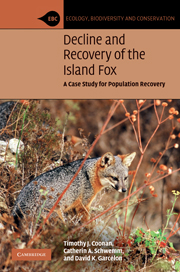Book contents
- Frontmatter
- Contents
- Foreword
- Acknowledgments
- 1 Introduction
- 2 Evolution and genetics
- 3 Social structure, reproduction, mortality and survivorship, and population dynamics
- 4 Food habits, habitat use, activity patterns, and dispersal
- 5 Golden eagles and the decline on the northern islands
- 6 Ecosystem recovery
- 7 Disease and decline on Santa Catalina Island
- 8 Recovery actions
- 9 Recovery actions
- 10 Reproductive biology, by Cheryl Asa
- 11 Diseases of island foxes, by Linda Munson
- 12 Zoos, education, and public participation
- 13 Managing recovery
- 14 The ecological role of island foxes
- 15 Conclusion
- References
- Index
9 - Recovery actions
Reintroduction and translocation
Published online by Cambridge University Press: 05 October 2010
- Frontmatter
- Contents
- Foreword
- Acknowledgments
- 1 Introduction
- 2 Evolution and genetics
- 3 Social structure, reproduction, mortality and survivorship, and population dynamics
- 4 Food habits, habitat use, activity patterns, and dispersal
- 5 Golden eagles and the decline on the northern islands
- 6 Ecosystem recovery
- 7 Disease and decline on Santa Catalina Island
- 8 Recovery actions
- 9 Recovery actions
- 10 Reproductive biology, by Cheryl Asa
- 11 Diseases of island foxes, by Linda Munson
- 12 Zoos, education, and public participation
- 13 Managing recovery
- 14 The ecological role of island foxes
- 15 Conclusion
- References
- Index
Summary
The intentional movement by humans of plants or animals from one location to another or from captivity back to the wild is an important tool in conservation. In both cases the goal is to augment existing populations (which may be at zero) to increase abundance and stimulate population growth rates (Morrison 2002). For island foxes both translocation (moving from one area to another) and reintroduction (moving from captivity to the wild) were successfully incorporated into recovery. On Santa Catalina Island translocation of foxes from the west end – where the population was stable – to the depleted east end accelerated growth of the east end population. Reintroduction was a critical recovery action on Santa Catalina and especially on the northern islands. The reintroduction of animals from captivity to the wild occurred on four islands, and on Santa Rosa and San Miguel it was the fundamental action responsible for recovery of the wild populations.
Translocation on Santa Catalina
Methods
Approximately 95% of the foxes remaining on Santa Catalina after the distemper outbreak (Chapter 7) were located on the western, smaller portion of the island (Timm et al. 2009). To promote recovery of the island's fox population, in late winter 2001 IWS began moving vaccinated wild foxes from the west to the east end. Juveniles (pups born that year) were selected rather than adults in the hope that the natural tendency of juveniles to disperse from adult home ranges would provide those individuals an advantage in unfamiliar surroundings.
- Type
- Chapter
- Information
- Decline and Recovery of the Island FoxA Case Study for Population Recovery, pp. 100 - 114Publisher: Cambridge University PressPrint publication year: 2010



